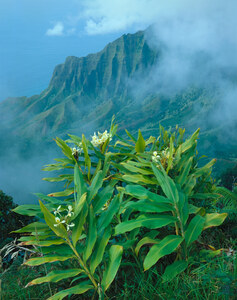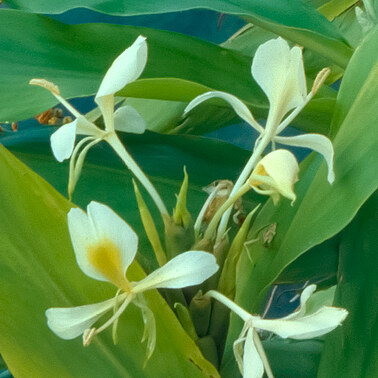
Yellow ginger and Kalalau Valley, Kaua'i
A region of Kaua'i, including most of the north and northwest coasts and much of the interior of the island, is one of the four places I have been that stand out for the fact that they are not national parks. The pali, cliffs, of this part of Kaua'i are the most spectacular in the islands. Similarly, the 600-year-old Na Pali Coast trail, which traverses the eastern portion of that few miles of coastline, is both the most spectacular and the roughest one which I have ever walked. At the end of the road that ascends northward to the high plateau atop Kaua‘i and passes the length of the west edge of Waimea Canyon, one reaches two overlooks at the brink of Kalalau Valley and the precipitous drop to the sea on the north-northwest side of the island. The valley is one mile wide, two miles long, and the drop to the sea from its rim is 5,000 feet. I had great expectations for this view, but when I got there I found solid fog and not a hint of what lay beyond. I had a sneaking suspicion that patience could be well rewarded though, so I started an image of an interesting plant nearby, and after about fifteen minutes I glanced over my shoulder and gasped at the sight revealed as the cloud began to part behind me. I raced back to the opening and quickly set up using the ginger plant as a foreground with the 8 1/4-inch lens and made three or four exposures, each with different foreground mist. The horizon is above the top of the image and the sea is visible below. A couple from my home town of Berkeley was there, saw all this and ordered a print on the spot. A few months later, I made them an 11 x 14 dye transfer.
Hawaii is very much characterized by certain consequences of the nature of the relationship between temperature, relative humidity, and absolute humidity. The water content of air at 100 percent relative humidity (the most water air can hold at any given temperature) doubles for each 20 degrees Fahrenheit the temperature is increased. So air at 80 degrees can hold eight times as much water vapor as air at 20 degrees, and so on. As air is lifted by flowing over mountains, it cools by 2.7 to 5.5 degrees for each 1,000 feet of lift (lesser amounts at higher humidities due to the moderating effects of the change of state of water from vapor to liquid and vice versa). So if air near saturation in the tropics is raised, for example, 4,000 feet, it will produce up to four times more rain than air elsewhere, at an initial temperature of 40 degrees less, being lifted the same amount. Therefore, tropical thunderstorms are wet; one spot on Kaua‘i has the highest average annual precipitation of any place on Earth—465 inches per year; and there are lots of rainbows in Hawaii. The rainbows happen because the moving, clear blue sky quickly turns first to cloud then to rain when encountering steep slopes. Clear sky is thereby closely juxtaposed with rain and when the sun is low the result is—rainbows.

